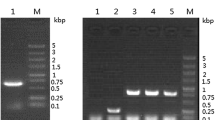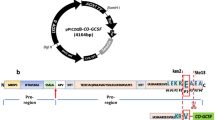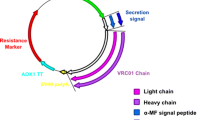Abstract
The cancer-testis (CT) antigen synovial sarcoma X break point 2 (SSX2) was expressed in Pichia pastoris as a means to produce a delayed-type hypersensitivity skin test reagent for monitoring SSX2-specific anti-cancer immune responses. SSX2 was detected intracellularly in P. pastoris despite the addition of the Saccharomyces cerevisiae alpha-mating factor secretion signal. Increasing the SSX2 gene copy number did not improve its secretion but did enhance intracellular SSX2 levels. SSX2 with its C-terminal nuclear localization signal (NLS) deleted (SSX2NORD), however, was secreted. Indirect immunofluorescence indicated that SSX2 containing the NLS did not translocate to the nucleus but accumulated in the endoplasmic reticulum (ER). Experimental results further suggested that SSX2 containing the NLS was misfolded in the ER, while deletion of the NLS facilitated correct folding of SSX2 inside the ER and improved its secretion. Production of SSX2NORD was scaled-up to a 2-L fermentor using a fed-batch protocol to maintain methanol at a concentration of 1 g L−1. Decreasing the cultivation temperature from 25 °C to 16 °C improved protein stability in the culture supernatant. In this process, after 120 h cultivation, the wet cell weight of P. pastoris reached 280 mg mL−1, and the yield of SSX2NORD was 21.6 mg L−1.










Similar content being viewed by others
References
Abdelmoula-Souissi S, Rekik L, Gargouri A, Mokdad-Gargouri R (2007) High-level expression of human tumour suppressor P53 in the methylotrophic yeast: Pichia pastoris. Protein Expr Purif 54:283–288
Ayyoub M, Stevanovic S, Sahin U, Guillaume P, Servis C, Rimoldi D, Valmori D, Romero P, Cerottini JC, Rammensee HG, Pfreundschuh M, Speiser D, Levy F (2002) Proteasome-assisted identification of a SSX-2-derived epitope recognized by tumor-reactive CTL infiltrating metastatic melanoma. J Immunol 168:1717–1722
Ayyoub M, Rimoldi D, Guillaume P, Romero P, Cerottini JC, Valmori D, Speiser D (2003) Tumor-reactive, SSX-2-specific CD8+ T cells are selectively expanded during immune responses to antigen-expressing tumors in melanoma patients. Cancer Res 63:5601–5606
Ayyoub M, Hesdorffer CS, Montes M, Merlo A, Speiser D, Rimoldi D, Cerottini JC, Ritter G, Scanlan M, Old LJ, Valmori D (2004) An immunodominant SSX-2-derived epitope recognized by CD4+ T cells in association with HLA-DR. J Clin Invest 113:1225–1233
Ayyoub M, Merlo A, Hesdorffer CS, Speiser D, Rimoldi D, Cerottini JC, Ritter G, Chen YT, Old LJ, Stevanovic S, Valmori D (2005) Distinct but overlapping T helper epitopes in the 37–58 region of SSX-2. Clin Immunol 114:70–78
Bader N, Jung T, Grune T (2007) The proteasome and its role in nuclear protein maintenance. Exp Gerontol 42:864–870
Boulikas T (1993) Nuclear localization signals (NLS). Crit Rev Eukaryot Gene Expr 3:193–227
Bricard G, Bouzourene H, Martinet O, Rimoldi D, Halkic N, Gillet M, Chaubert P, Macdonald HR, Romero P, Cerottini JC, Speiser DE (2005) Naturally acquired MAGE-A10- and SSX-2-specific CD8+ T cell responses in patients with hepatocellular carcinoma. J Immunol 174:1709–1716
Cereghino GP, Cereghino JL, Ilgen C, Cregg JM (2002) Production of recombinant proteins in fermenter cultures of the yeast Pichia pastoris. Curr Opin Biotechnol 13:329–332
Chawla A, Niwa M (2005) The unfolded protein response. Curr Biol 15:R907
Clark J, Rocques PJ, Crew AJ, Gill S, Shipley J, Chan AM, Gusterson BA, Cooper CS (1994) Identification of novel genes, SYT and SSX, involved in the t(X;18)(p11.2;q11.2) translocation found in human synovial sarcoma. Nat Genet 7:502–508
Damasceno LM, Pla I, Chang HJ, Cohen L, Ritter G, Old LJ, Batt CA (2004) An optimized fermentation process for high-level production of a single-chain Fv antibody fragment in Pichia pastoris. Protein Expr Purif 37:18–26
Damasceno LM, Anderson KA, Ritter G, Cregg JM, Old LJ, Batt CA (2007) Cooverexpression of chaperones for enhanced secretion of a single-chain antibody fragment in Pichia pastoris. Appl Microbiol Biotechnol 74:381–389
Davis ID, Chen W, Jackson H, Parente P, Shackleton M, Hopkins W, Chen Q, Dimopoulos N, Luke T, Murphy R, Scott AM, Maraskovsky E, McArthur G, MacGregor D, Sturrock S, Tai TY, Green S, Cuthbertson A, Maher D, Miloradovic L, Mitchell SV, Ritter G, Jungbluth AA, Chen YT, Gnjatic S, Hoffman EW, Old LJ, Cebon JS (2004) Recombinant NY-ESO-1 protein with ISCOMATRIX adjuvant induces broad integrated antibody and CD4+ and CD8+ T cell responses in humans. Proc Natl Acad Sci U S A 101:10697–10702
Don RH, Cox PT, Wainwright BJ, Baker K, Mattick JS (1991) ‘Touchdown’ PCR to circumvent spurious priming during gene amplification. Nucleic Acids Res 19:4008
dos Santos NR, de Bruijn DR, Kater-Baats E, Otte AP, van Kessel AG (2000) Delineation of the protein domains responsible for SYT, SSX, and SYT-SSX nuclear localization. Exp Cell Res 256:192–202
Gorlich D (1997) Nuclear protein import. Curr Opin Cell Biol 9:412–419
Gure AO, Tureci O, Sahin U, Tsang S, Scanlan MJ, Jager E, Knuth A, Pfreundschuh M, Old LJ, Chen YT (1997) SSX: a multigene family with several members transcribed in normal testis and human cancer. Int J Cancer 72:965–971
Higgins DR, Cregg JM (1998) Introduction to Pichia pastoris. Methods Mol Biol 103:1–15
Hohenblum H, Borth N, Mattanovich D (2003) Assessing viability and cell-associated product of recombinant protein producing Pichia pastoris with flow cytometry. J Biotechnol 102:281–290
Hong E, Davidson AR, Kaiser CA (1996) A pathway for targeting soluble misfolded proteins to the yeast vacuole. J Cell Biol 135:623–633
Huang C, Chen RH, Vannelli T, Lee F, Ritter E, Ritter G, Old LJ, Batt CA (2007) Expression and purification of the cancer antigen SSX2: a potential cancer vaccine. Protein Expr Purif 56:212–219
Jahic M, Wallberg F, Bollok M, Garcia P, Enfors SO (2003) Temperature limited fed-batch technique for control of proteolysis in Pichia pastoris bioreactor cultures. Microb Cell Fact 2:6
Jahic M, Veide A, Charoenrat T, Teeri T, Enfors SO (2006) Process technology for production and recovery of heterologous proteins with Pichia pastoris. Biotechnol Prog 22:1465–1473
Kaufman RJ (1999) Stress signaling from the lumen of the endoplasmic reticulum: coordination of gene transcriptional and translational controls. Genes Dev 13:1211–1233
Macauley-Patrick S, Fazenda ML, McNeil B, Harvey LM (2005) Heterologous protein production using the Pichia pastoris expression system. Yeast 22:249–270
Nagai M, Tanaka S, Tsuda M, Endo S, Kato H, Sonobe H, Minami A, Hiraga H, Nishihara H, Sawa H, Nagashima K (2001) Analysis of transforming activity of human synovial sarcoma-associated chimeric protein SYT-SSX1 bound to chromatin remodeling factor hBRM/hSNF2 alpha. Proc Natl Acad Sci U S A 98:3843–3848
Neumann F, Wagner C, Stevanovic S, Kubuschok B, Schormann C, Mischo A, Ertan K, Schmidt W, Pfreundschuh M (2004) Identification of an HLA-DR-restricted peptide epitope with a promiscuous binding pattern derived from the cancer testis antigen HOM-MEL-40/SSX2. Int J Cancer 112:661–668
Okamura K, Kimata Y, Higashio H, Tsuru A, Kohno K (2000) Dissociation of Kar2p/BiP from an ER sensory molecule, Ire1p, triggers the unfolded protein response in yeast. Biochem Biophys Res Commun 279:445–450
Pechan T, Ma PW, Luthe DS (2004) Heterologous expression of maize (Zea mays L.) Mir1 cysteine proteinase in eukaryotic and prokaryotic expression systems. Protein Expr Purif 34:134–141
Petrovsky N, Brusic V (2004) Virtual models of the HLA class I antigen processing pathway. Methods 34:429–435
Resina D, Bollok M, Khatri NK, Valero F, Neubauer P, Ferrer P (2007) Transcriptional response of P. pastoris in fed-batch cultivations to Rhizopus oryzae lipase production reveals UPR induction. Microb Cell Fact 6:21
Scanlan MJ, Gure AO, Jungbluth AA, Old LJ, Chen YT (2002) Cancer/testis antigens: an expanding family of targets for cancer immunotherapy. Immunol Rev 188:22–32
Shamu CE, Cox JS, Walter P (1994) The unfolded-protein-response pathway in yeast. Trends Cell Biol 4:56–60
Sitia R, Braakman I (2003) Quality control in the endoplasmic reticulum protein factory. Nature 426:891–894
Smith JD, Robinson AS (2002) Overexpression of an archaeal protein in yeast: secretion bottleneck at the ER. Biotechnol Bioeng 79:713–723
Tureci O, Sahin U, Schobert I, Koslowski M, Scmitt H, Schild HJ, Stenner F, Seitz G, Rammensee HG, Pfreundschuh M (1996) The SSX-2 gene, which is involved in the t(X;18) translocation of synovial sarcomas, codes for the human tumor antigen HOM-MEL-40. Cancer Res 56:4766–4772
van der Bruggen P, Van den Eynde BJ (2006) Processing and presentation of tumor antigens and vaccination strategies. Curr Opin Immunol 18:98–104
Vassileva A, Chugh DA, Swaminathan S, Khanna N (2001) Expression of hepatitis B surface antigen in the methylotrophic yeast Pichia pastoris using the GAP promoter. J Biotechnol 88:21–35
Acknowledgment
We would like to thank Dr. Charles K. Barlowe from Dartmouth College for providing the anti-Kar2p for our Kar2p analyses. This project was funded by the Ludwig Institute for Cancer Research.
Author information
Authors and Affiliations
Corresponding author
Rights and permissions
About this article
Cite this article
Huang, CJ., Anderson, K.A., Damasceno, L.M. et al. Improved secretion of the cancer-testis antigen SSX2 in Pichia pastoris by deletion of its nuclear localization signal. Appl Microbiol Biotechnol 86, 243–253 (2010). https://doi.org/10.1007/s00253-009-2275-2
Received:
Revised:
Accepted:
Published:
Issue Date:
DOI: https://doi.org/10.1007/s00253-009-2275-2




